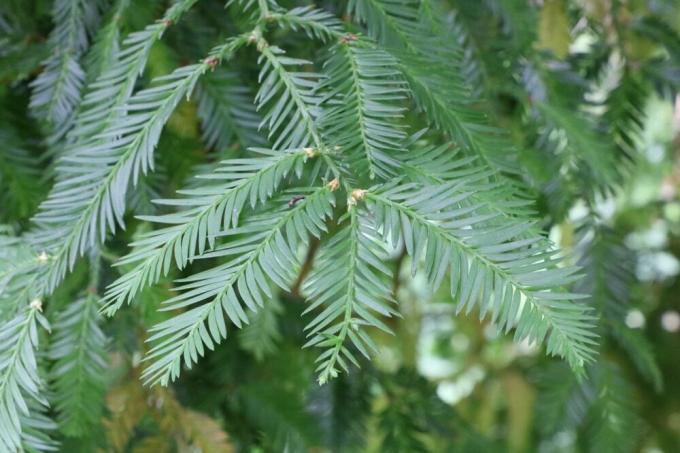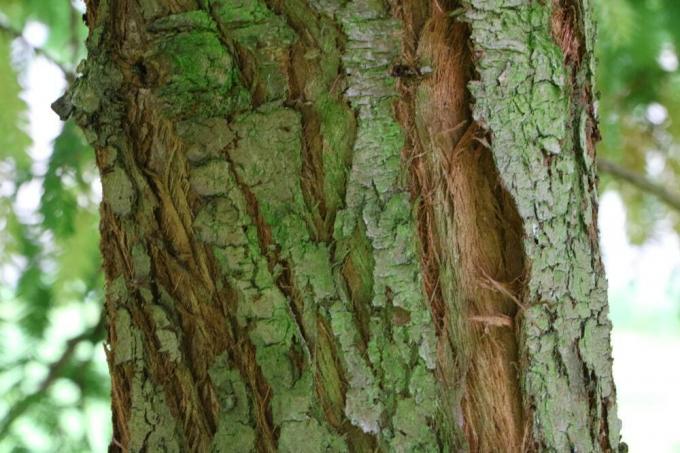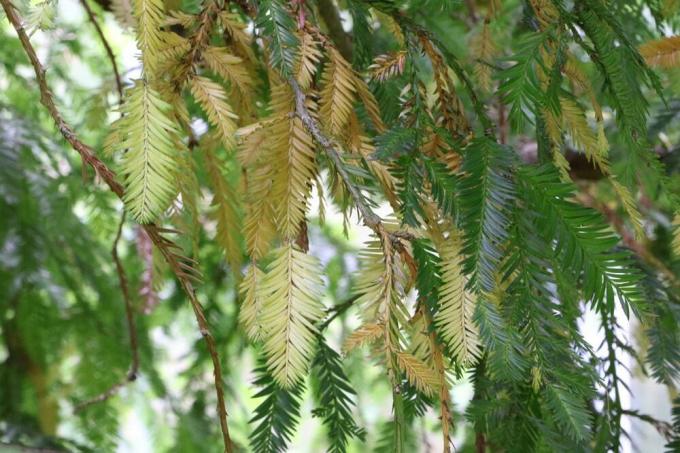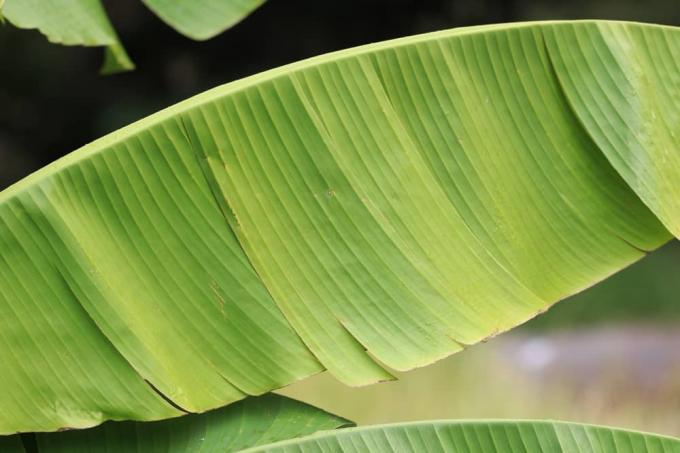

Table of contents
- Characteristics
- Cultivation from seeds
- 1. Stratify seeds
- 2. Prepare containers with potting soil
- 3. Sow sequoias
- 4. Maintain breeding containers
- 5. Prick young plants
- 6. rearing of the young plants
- 7. Get used to the outdoor air
- 8. hibernate
- 9. plant out
- 10. The further care
- Choosing the right sequoia: species and varieties
- Metasequoia glyptostroboides
- Sequoiadendron giganteum
- Sequoia sempervirens
Sequoias are something very special: Fantastically fast growth of up to 2 m per season, with around 70 million years Development history among the oldest woody plants on earth and so rare that there are only three species left in the whole world there. Because the sequoias also hold the records for "tallest tree" and (almost) "thickest tree", only a few species/cultivars are of interest to private gardeners. Below you will find out what sequoias these are, how to grow them yourself from seeds and how to care for them:
Characteristics
- Sequoias are conifers from the cypress family
- Their subfamily, the Sequoioideae, has been traced back to the Cretaceous by biological research
- At that time there were at least a dozen different sequoias, of which only three genera, each with three species, have survived
- These are the Californian mountain redwoods and coast redwoods, as well as the primeval redwood discovered in China
- Primeval redwoods are the redwoods for home gardens
- They get along best with our climate and remain as a cultivar at garden-friendly heights
- Some varieties of the mountain sequoia also do well in our climate as older trees
- In cultivars that grow more compactly than the up to 100 m high original
- Which are nevertheless only recommended for planting in exceptionally spacious gardens
First of all, because important:
Never plant any sequoia in any spot in the garden without thinking! Two out of three sequoia species have no place in the normal home garden, specimens of the right variety have to spend the first year in the bucket; Above all, you must study your tree protection law very carefully before planting a sequoia. In some federal states, every tree is protected from a trunk circumference that is not very enormous, except for the species expressly listed; this is where a sequoia can achieve protected status before you realize it may be growing too outrageously proportions for your garden.
Cultivation from seeds
If you already know which sequoia you want to raise (if you don't already know, you should start by reading the section "The Choosing the Right Sequoia: Species and Varieties"), you can get started as soon as the seeds have been delivered, according to the following Step-by-step instructions:
1. Stratify seeds
Sequoia seed is subject to germination inhibition, which in nature ensures that the seed that has ripened in autumn does not start immediately and then does not enjoy much in the cold season. While seasonal goods are usually stratified by the retailer so that impatient gardeners can get started in spring, sequoia seeds are traded year-round. That's why the stratification is left to you, that's why the seed can be sown all year round.

Normally, the germ inhibition is reduced by the winter cold, if that is not at hand, the refrigerator can take over this task. The seeds remain there for different lengths of time depending on the tree species, and the temperature may also have to be adjusted a little. Here are the stratification requirements of the three sequoia species:
- Primeval redwood seeds: 5 - 7 degrees, 5 to 10 days, then soak in lukewarm water overnight (12 hours).
- Mountain Sequoia: 5 degrees down and a longer stratification duration
- There are many opinions as to how long exactly, from a few days to 2 months
- A stratification period of 14 days seems to bring the most success
- Subsequently, mountain sequoia seeds should also be soaked for 12 - 24 hours. to be soaked
- Coast redwood seeds are stratified at 5 degrees or less
- Duration of stratification: See mountain sequoia, here also brings approx. 14 days stratification arguably the best success rate
- Subsequent soaking is not recommended for coast redwood seeds, they can be put straight into the potting soil
Stratification information is never entirely accurate, since the optimal values depend on many factors (humidity in the retailer's warehouse, seed maturity at harvest, age of the seeds, etc.). If you want to germinate seeds safely (sequoia seeds are usually sold in batches of 30 to 50, Apparently the dealers also assume that the failure rate is not insignificant), you should buy the seeds in batches sowing. Start with batch 1 with the smallest values of the recommendations, if these first seeds fail, stratify the batch 2 seeds a little longer and/or colder.
2. Prepare containers with potting soil
While the seeds are stratifying, you can take care of the growing containers and soil. The cultivation containers should be covered with a translucent cover, you can use indoor greenhouses with an integrated lid or the Cultivation pots with matching panes of glass, transparent plastic containers (upcycling of the last lettuce or tomato packaging) or foil hoods cover.
Several variants of potting soil are recommended:
- Garden soil, humus and sand, mixed in equal parts
- Suitable for primeval redwoods that will soon be planted in the garden, as they are already used to the local microorganisms
- Pure coconut soil, also known as coco hum
- Recommended for the cultivation of tub sequoias, later also mix into the tub substrate
- Kokohum, under which crushed eggshells are mixed
- Eggshells are made of carbonate of lime, suitable for coast redwoods that also grow on limestone
- Coconut soil mixed with some wood ash
- Mountain redwoods and coast redwoods are said to have germinated after several failed attempts (in their natural habitat they germinate after forest fires).
3. Sow sequoias
When the seed tray and seeds are ready, the seeds can be planted in the ground. More specifically, on the ground, all redwoods are light germinators and are scattered loosely on the potting soil as seeds.
4. Maintain breeding containers
Lightly fix seeds with soil, set up the cultivation container in a bright (not sunny) sheltered location. Cover the growing container and keep the soil constantly moist (not wet!), ventilate regularly to avoid mold growth.
Primeval redwoods germinate in 1 - 3 weeks, mountain redwoods and coast redwoods should need 2 - 5 weeks until the first stirrings. If in doubt, continue to look after the breeding container for a while - there are said to have been sequoias that took months to germinate.
5. Prick young plants
When the young plants have thrived to the extent that they seem reasonably stable (at the earliest five weeks after germination), the seed trays can be uncovered. When the young plants have gotten used to the drier air after a few days, they are placed individually in the pots (= transplanted).

The soil mix should follow what you used as potting soil, but be a good deal more nutritious (this is when the big growth is supposed to start).
6. rearing of the young plants
The young plants are further cared for in a sheltered location away from direct sunlight.
Primeval redwoods can stand in half shade to half shade, mountain redwoods and coast redwoods also tolerate fairly light partial shade.
The young plants must be kept well moist all the time because the fine, young roots dry out and die off very quickly.
7. Get used to the outdoor air
It doesn't matter whether your sequoia is to be planted out in the garden later or to eke out its life in a bucket: Sequoia trees belong in the summer If kept indoors, they will die sooner or later due to lack of light (there are none for sequoia keeping under plant light empirical values).
However, there are empirical values that a little open air is indispensable even for the young plants, because they can twist their ankles if they are only reared indoors tend to grow (shoots grow longer than they gain in strength/stability) and mold growth is often unavoidable in rooms with stagnant air is.
First put it in a sheltered place without direct sun, gradually you can let the young plants in little "stress", "with the sun and wind blowing your nose", so you ensure that robust, strong little trees grow develop.
8. hibernate

Depending on the type, variety and start of cultivation, the sequoia trees spend the first one to four years protected. Location for all three sequoias as usual, bright and quiet, please not near the heating because of the dry air in winter.
9. plant out
If possible, after 1 - 4 years (depending on species, variety and start of cultivation), in fresh, nutrient-rich garden soil, in a location with sun or light semi-shade.
Autumn is the best time to plant out in the garden, while the soil is still warm enough.
Tip:
Before planting, you might want to see live what a particular sequoia can become in the climate of your area, just to be safe. The German Sequoia Register (mbreg.de/wiki/index.php/Mammutbaum-Register_Deutschland) tells you where you can see which sequoias in your region.
10. The further care
When you've made it this far, it becomes simple:
- Supplemental watering only required in very sunny locations/extremely hot weather
- On normally nutrient-rich soils, give a little fertilizer every spring for the first few years
- Thin out older sequoias by pruning if they grow too dense
Choosing the right sequoia: species and varieties
Sequoias (Sequoioideae) belong to the conifer order and within this to the cypress family (cypress, juniper and arborvitae). The subfamily could be traced back to the Cretaceous period, from at least a dozen different sequoias only three genera, each with three species, are left today:
In the northern hemisphere, the genus Metasequoia emerged from the ten or so species of this genus only the primeval redwood Metasequoia glyptostroboides has it in a hidden mountain region in China survived.
Of the three sequoia species, it is by far the most suitable for planting in human settlements: In the wild at most 40 meters high, compared to the other two sequoias quite a tiny thing, tree nursery goods still hold up a bit in height growth more back.
It is familiar with the cold of winter and sheds its needles in autumn, but is the only sequoia in the warm season that is permanently green almost to the ground Needle dress (the foliage of the other two species increases a little every year until you only look more closely at the lowest side shoots with binoculars can). Before the primeval redwood drops its needles in winter, it develops the beautiful autumn colors that have earned it the middle name "Chinese Redwood".
Because of all these advantages, the primeval sequoia has continuously conquered more and more areas of the world as an ornamental tree for parks and gardens. In the meantime it has long since arrived and is sold in tree nurseries. It is said to grow as well here as in its native China, although the climate there is milder. However, it is only suitable for single placement in sufficiently large gardens, because the cultivars also change per season 50 cm until it reaches a height of between 25 and 35 meters and a growth width of between 7 and 10 meters have.
You can sometimes read about young primeval redwoods that they can be planted outdoors in their first year. You should really only attempt this with early germinated primeval redwoods that have thrived until fall (and then with winter protection). Most sources recommend sheltering primeval redwoods indoors for the first winter.
Tip:
With a primeval sequoia you put a "climate protection tree" in your garden: primeval sequoias are said to be very good Being carbon sinks, i.e. absorbing and storing a lot of carbon dioxide from the air during growth. Therefore, there should already be initial approaches to using primeval redwoods for forestry purposes.
Sequoiadendron giganteum
Giant sequoias (mountain sequoias) grow in California and are among the thickest trees in the world. The original Sequoiadendron giganteum should therefore not come too close to the German home garden, but there are compact cultivars. These cultivars have been bred to be more winter hardy, in the tree nursery you can find out which variety can be planted out and when.

Tip:
The average home garden is overwhelmed with a giant sequoia, and unfortunately very few of us have a park on our doorstep. However, it is the only species of sequoia that can be cultivated well in a bucket. In the bucket you can enjoy the rapid growth in your youth without having to worry that the wood will eventually "grow out" of the proportions of your home. You can also control the height yourself by allowing the wood more or less root space (up to towards "very little root space", with the Sequoiadendron giganteum even shaping into a bonsai should be possible be). The alternative could be a garden location for just a few years: the conifers = softwoods should look a lot like a Christmas tree when young.
Sequoia sempervirens
With the "California Redwoods", coast redwoods are currently the tallest trees in the world. They would therefore only be suitable for really spacious parks, but are sensitive to frost and not hardy in most areas of Germany.
There are individual breeding attempts, e.g. B. on the friendly Lower Rhine and in the Berlin Botanical Gardens, if you are interested in this species Be sure to consult such specialists before breeding/planting out with regard to winter hardiness and protection consult.
 garden editorial
garden editorial I write about everything that interests me in my garden.
Learn more about potted plants

Abalie, Abelia grandiflora: 14 tips for proper care
The large-flowered abalia (Abelia grandiflora) is an extraordinarily easy-care ornamental shrub that delights with numerous funnel-shaped and subtly scented flowers. It is just as suitable as a background plant as a hedge or container plant.

Caring for the tangerine tree properly | 13 tips for the tangerine tree
Many citrus plants have evolved from the tangerine, one of the oldest and most original citrus species. With its white flowers and orange fruits, it is a feast for the eyes and the palate. In this country it is only cultivated as a container plant due to its sensitivity to frost.

Indian canna, Canna indica | 13 tips for care
Canna indica, also known by the botanical name Canna indica, is a decorative plant that not only enriches every garden during flowering. In pot culture, it can be used as an accent for many years thanks to its color and growth.

11 absolutely hardy container plants
Absolutely hardy potted plants have several advantages to offer, because they can remain outdoors even when the temperature is below zero and require little protection. If they are also evergreen, they can also bring joy all year round.

Is dwarf bamboo hardy? | 11 tips for care & cutting
Dwarf bamboo is one of the easy-care sweet grasses. In the garden, it can be used as a good ground cover, as it does not grow as tall as its larger relatives. Whether the plant is hardy and how it is cared for and cut can be read in the guide.

Pink dwarf banana, Musa velutina | Care of the Kenya Banana
The pink dwarf banana (Musa velutina) is an eye-catcher in the garden. It grows to a maximum of two meters and impresses with its impressive flowers. The small pink fruits taste sweet and aromatic. If you want to harvest the exotic fruits, you should follow our care tips.



